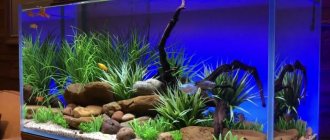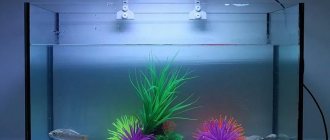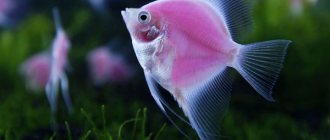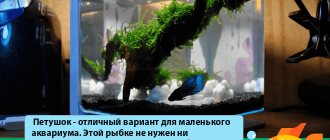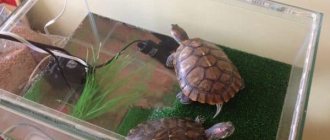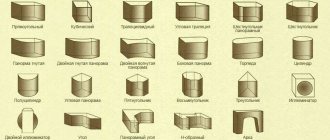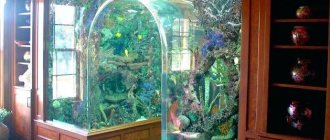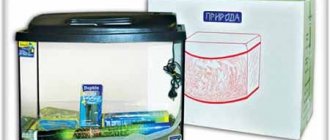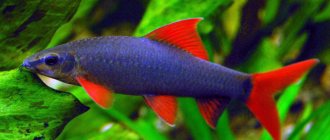Disadvantages of this form
Let's summarize the counterarguments that may arise before purchasing a corner aquarium:
- All other characteristics being equal, aquariums of this form are more expensive and have a smaller assortment in stores.
- As a rule, they require the purchase of an appropriate cabinet for installation.
- Simple and affordable aqua designs will not work. It is necessary to decorate according to the far corner.
- If the equipment built into the lid breaks down, repairs will also cost significantly more than for the classic form.
- As an herbalist, this space is inconvenient due to uneven lighting.
- Rectangular aquariums of a non-built-in type have a better view of the inhabitants of the aquarium than a corner aquarium.
Which aquarium is better to choose and buy?
What else should you consider when choosing the best aquarium?
Aquarium shapes
photo Corner aquarium Panoramic-corner Rectangular With convex glass Panoramic Octahedron more shapes Now let's look at it clearly
most popular aquarium shapes
RECTANGULAR AQUARIUMS PHOTO PANORAMIC AQUARIUMS PHOTO WITH A CURVED FRONT WALL PHOTO CORNER AQUARIUM PHOTO ROUND AQUARIUM PHOTO EXCLUSIVE AQUARIUMS WITH UNUSUAL SHAPE PHOTO
Types of aquariums by purpose
fanfishka.ru>
Types of corner aquariums
10 liter aquariums: varieties, selection, equipment and maintenance.
Based on their shape, there are 3 types of corner aquariums:
- L-shaped;
- Triangular;
- Panoramic.
Each of them has its own advantages and disadvantages.
- The L-shaped look should be chosen by those who want to zone the room without reducing the space. With its help, you can advantageously separate the office space from the recreation area, or, for example, the guest room from the dining room. Designers recommend using this option for owners of studio apartments that have become popular recently.
- The triangular view is ideal for depth viewing. Its only drawback is the corner joint, which is not visible to the naked eye and if there is a leak there, it will be extremely difficult to detect the fault in a timely manner.
- The panoramic view can be either L-shaped or triangular. Its main difference is the front windows concave or curved outwards. This design trick allows the viewer to more closely examine all the details of the interior decoration.
Minuses
Distorted view On aquarium forums, users note the impracticality of corner aquariums with panoramic glass concave inward or outward: the view of the interior is distorted and the inhabitants look unnaturally large or too small. This problem is easily solved by installing a corner vessel with straight glass, which will not interfere with long-term observation of fish. Low lighting There is an opinion that a corner aquarium is dimly lit by default, which can negatively affect some of its inhabitants. But there is a solution here: LED lighting and additional lamps will provide adequate lighting to its most demanding residents
In addition, decorative lamps attract the attention of others. Difficulties in setting up and planting plants Many find it difficult to organize the space inside the container due to the non-standard shape. This problem is faced by people who are accustomed to the traditional square or rectangular shape, which, most likely, was located along the wall, opening up views from 3 sides
It is worth noting that people who have cared for round ones in the past (with all-round visibility) do not encounter difficulties in arranging a corner aquarium, but, on the contrary, note the ease in choosing furnishings and decor.
A corner aquarium is an ideal solution for those who are not ready to sacrifice extra space and value safety and practicality!
Placement and design of a corner aquarium
Selection and arrangement of a cage for an African pygmy hedgehog
Plants and fish are selected by the owner at his own discretion. Limitations in the choice of fish arise only due to the volume of the tank. It is necessary to accurately calculate the possible number of fish by volume. This is easy to do - just leave 2-4 liters of water for each fish.
The design of the corner aquarium is selected according to the style of the room. A background film is attached to the back wall, which depicts the water world, plants, and stones. It is better to take a neutral background that will not stand out from the overall design of the room. Aquarists recommend making a dark general background; it will make a small body of water visually deeper.
The side walls are covered with film or left untouched, then tall plants are planted on the sides or decor is installed. Equipment in a corner tank is placed in the far corner.
It is recommended to lay out the soil in a corner container in a heap. In the frontal zone, the thickness of the soil should be minimal, and in the farthest corner a high slide should be built. By arranging the soil with a slide, you can visually level the depth of the aquarium.
Plants are planted in the tank according to the same rule: large, tall plants are planted in the far corner, and short ones are brought to the foreground. Tall plants in the background will hide all the equipment.
Before choosing a corner to install the aquarium, you should make sure that there is an outlet nearby. All equipment in the aquarium is powered by electricity. You should not place the aquarium next to equipment that creates noise, a microwave oven, or heating elements. Keep the aquarium out of direct sunlight and drafts.
Living room and aquarium: made for each other
What does a Pomeranian Spitz look like: photos of dogs, description of the standard, varieties of the breed and main colors + choice of puppy
The aquarium in the living room interior looks great and fits well into any style solution. It is not only a decorative element, but also creates a unique interior, makes the atmosphere cozy, helps you relax after a hard day, distract yourself, and switch from negative emotions to positive thoughts.
Even a few minutes of watching fish greatly improves your mood
A small aquarium does not take up much space and is easy to transport
The floor-standing version of the aquarium in the interior of the apartment takes up a lot of space and is suitable for spacious rooms. If you have to save every centimeter of usable space at home, then it is better to integrate an aquarium with an underwater landscape into the wall. Built-in containers give a special mood and become a kind of living picture that will never get boring. Aquariums are integrated into a chest of drawers, a cabinet, they can connect two rooms with a picturesque translucent “window”. The corner design allows for successful use of space, looks original, and creates a panoramic view.
A massive aquarium is perfect for zoning a room
“Living pictures” are popular - flat rectangular aquariums on the wall. They are framed with a baguette, which gives the feeling of a real work of art. Designers suggest incorporating the underwater world into a billiard table, into the space above the sofa or at its head. The aquarium under the TV in the interior looks very interesting.
In a flat picture aquarium you can keep only the most unpretentious fish
You can not only buy a suitable container, but also order a design for an aquarium in the interior of your apartment according to your drawings. The size should correspond to the area of the living room, not overload the room, the presence of other decorative elements should be taken into account - floor vases, figurines, and so on.
Tall aquarium in the interior of a modern living room
“Water ribbon” as a decoration for the kitchen-living room
The location of the beautiful underwater kingdom is important. The aquarium should be clearly visible from anywhere in the room
Choose a place comfortable for fish at some distance from radiators or speaker systems.
How to choose a container for different rooms?
Each room has its own characteristics. If you decide to install an aquarium in a room, then first of all you should take into account its functionality. Based on this, the appropriate model, shape and configuration is selected. This will allow you to create an individual room interior with a comfortable environment.
Tasteful interior design
Bedroom
Here you need to install medium or small models. They should have a simple style. The main purpose of the room is a calm, quiet rest after a busy day. Therefore, it would be inappropriate to place bright and catchy containers with live fish here.
If it is not possible to care for underwater inhabitants, then you can install a dry aquarium or its imitation. Thanks to this, there will be no need to regularly change the water and install special lighting.
Peaceful rest after a hard day
Living room
Guests always gather in this room. Therefore, the aquarium can be placed on the wall or in a special niche.
Advice To impress people around you, you need to install only a classic model with a rich underwater world. The equipment can be mounted in a column, partition or used as a table.
Aquarium in the living room - choose a convenient place
If the room has a small area, then it is appropriate to use the container as a partition that separates the workplace and the relaxation area. This will save space and will also be an interesting solution for creating an interior.
Decor
Arranging and decorating a corner container is a relatively simple procedure. And if you follow certain principles, then even an inexperienced aquarist can cope with the process.
- The substrate, algae and vegetation are selected taking into account what phenotypes and mollusks will be settled in the tank.
- Determination and maintenance of aquarium water parameters. In order for fish and shellfish to feel comfortable, develop and reproduce, the condition of the water must be carefully monitored. Using special equipment, acidity, density and hardness are periodically measured.
- Installation of a mechanical (internal or external) filter, aerator. The frequency of replacing (cleaning) the mechanical filter is set individually.
- Heating equipment. It is necessary to maintain the specified temperature.
- Lighting equipment. Fluorescent lamps are suitable for corner aquariums. When determining the power level, the characteristics of fish and vegetation are taken into account. Some phenotypes require long periods of daylight.
When designing a corner tank, the characteristic features of the phenotypes and the need for shelter or free space are taken into account. Some types of fish need oxygen. Therefore, there is a need to install additional equipment.
If you choose the right corner aquarium, you can make the interior more interesting and attractive. Among the variety of designs, every aquarist will be able to choose the option that suits all parameters. Only by correctly selecting, installing and designing a corner aquarium can you get rid of the problems associated with breeding fish and shellfish.
How to choose an aquarium for a beginner
A common mistake made by beginners in aquarium keeping is to start with too small volumes. In fact, a small volume of water will mean frequent changes and constant filter cleaning. It is impossible to create a balanced ecosystem in such a space. Therefore, if the choice is a triangular jar, it is better to choose a corner aquarium of 200 liters or more. This will give scope both in terms of the use of large decor - stones, driftwood, and in the choice of aquatic inhabitants.
View gallery
You should also not opt for containers that are too high (from 60 centimeters), the problem with lighting also applies here - the plants will not take root.
Features of aquarium arrangement
Aquariums are one of the most popular hobbies of the world's population. She knows no boundaries, boundaries and national hatred. Exhibitions are held annually to showcase new fashion trends. They are created by aquarium designers who have received worldwide recognition.
The aquarium itself is a complex closed ecosystem.
Features of the arrangement of a particular reservoir depend on the following factors:
- What is the purpose of the aquarium? It can be decorative, species, spawning.
- Where it will be located: apartment, office, exhibition center and so on.
- Freshwater or marine.
- What kind of fish and plants do you plan to populate the vessel with?
- A lot depends on the shape and size of the jar. They are rectangular, square, corner, round.
Rules for designing an aquarium
There are general rules for arranging an artificial reservoir.
When creating aquadesign, you should strictly adhere to the following steps:
- It is necessary to decide on the fish that will populate the reservoir.
- Select plants, shellfish and aquaculture for them.
- Select soil.
- Decide on the size and shape of the vessel.
- Select and install equipment.
- Decor.
- Launch.
Choosing a location for an aquarium: what to consider
First of all, you need to take into account the characteristics of the room in which you plan to place the aquarium: area, ceiling height, location, place where you plan to place the container
Why is this so important? Because, for example, an aquarium cannot be placed in a room that faces south, since due to direct sunlight the water will begin to bloom
Photo: timesofisrael.com
You will have to decide in advance on the number of fish and their sizes, since the choice of aquarium model will depend on this. It is not advisable to release small inhabitants into huge containers that require careful and expensive care.
How to choose a corner aquarium?
The design of the corner aquarium is different. Two main models are presented:
- Containers with convex glass. They are suitable for installation in a dark place. After all, panoramic glass distorts the size of vegetation, shellfish and fish. When rays of light hit, glare occurs.
- Tanks with straight glass. When selecting such an aquarium, one takes into account how wide the edges are. To get maximum visibility, edges should have a minimum width.
Cabinet
When choosing a corner aquarium with a cabinet, you determine not only the tank that has suitable characteristics. A stand with the required parameters is also selected for the container.
A corner-shaped stand will fit perfectly into the interior. Its use helps to save space and ease of use. A custom-made cabinet is also suitable for corner containers. In this case, drawings are prepared and measurements are taken.
In order to select furniture for a container with fish, the optimal size is determined:
- Small-sized products. They are designed to accommodate tanks whose volume does not exceed 100 liters.
- Medium-sized products. Containers with a volume of 120–130 liters are installed on such a stand. The length of such furniture reaches 80 cm.
- Large items. They are used if the volume of the aquarium reaches 240–300 liters. Before installing the tank, the stand is checked. If the strength level is low, then over time the cabinet will collapse.
Watch a video on how to quickly make a corner cabinet
A variety of materials and elements are used to prepare the stand. When selecting raw materials, it is worth considering not only the design of the corner aquarium, but also the degree of moisture resistance. The main materials used for these purposes:
- Wood. The cost of products made from such raw materials is quite high. Therefore, aquarists buy them infrequently. In addition, wooden stands are periodically treated with protective compounds in order to reduce the harmful effects of moisture.
- MDF or chipboard. Models made from this material are distinguished by their optimal cost. They are complemented by shelves, doors, and other elements. Such stands should not be used for panoramic tanks.
- Metal. The metal structure is considered reliable and durable. Aquariums with a volume exceeding 300 liters are placed on a metal stand.
The stands differ not only in size, material, but also in configuration. Some manufacturers provide the opportunity to select the optimal number of shelves, decorative elements, and accessories
When choosing a cabinet, it is important to take into account the design of the corner aquarium.
Useful tips
To make their work easier, beginners should pay attention to a number of useful tips from experienced specialists. They are simple, but will help you avoid many troubles both at the initial stages and in the future.
When choosing, filling and decorating an aquarium, you should consider:
- If you have a small room, then a square aquarium is best. It can be placed in a corner or even in the middle of the room.
- Living room. A designer pond with a view is best suited for it. There are options without fish, exclusively with decorative elements.
- The ecosystem of large vessels is more stable than small ones.
- When cleaning the aquarium, no chemicals are used. The best is warm water with vinegar.
- Instead of a soil scoop, you can use a cut plastic bottle.
- Sometimes interesting objects are fixed on the walls or bottom. Silicone glue is used for this.
- The soil is laid out with a slight slope. To prevent it from moving, it is recommended to strengthen it with plastic terraces or stones.
- You should not use natural shells for decoration. Due to the large amount of calcium released into the water, they change its composition and hardness.
- Choose aquarium decorations made from safe materials.
- It is prohibited to make decorations from alkaline materials. They change the chemical composition of water. They make it unsuitable for fish.
- When choosing stones, avoid sharp edges. They can cause injury to fish.
- A round jar does not need a background.
- To lay the soil in colored stripes, simply insert cardboard sheets between them as limiters, and then pull them out.
- It is important to choose the right plants. Sometimes a few inexpensive popular species will be enough to fill the water space in an original way.
- Some plants with a strong root system are best planted in pots or clay containers filled with nutrient soil. In the future, the decoration will not deteriorate, and the plant can be easily removed and rearranged.
- To make the fish look brighter, a dark shade of soil is recommended.
- Oak driftwood is not recommended; this wood stains the water.
- Before placing in a pond, stones and shells collected with your own hands must be boiled for 5-10 minutes for disinfection.
- Individual parts of the aquarium, as well as plants such as moss, are secured with transparent fishing line or clamps.
- You need to select the fish you would like to purchase in advance. Find out everything about the features of their content. Focus only on species that get along together and have similar conditions of detention.
- After purchasing the fish, you must quarantine them for a week in a separate aquarium. This is done in order not to introduce infection into it and not to destroy the remaining inhabitants.
- Figurines, amphorae, monuments and castles placed in an aquarium require regular cleaning.
- Water parameters should be constantly measured and maintained.
- When selecting an aquarium and designing it, you should definitely take into account ease of maintenance. We must remember that cleaning, cleaning, and changing water can take a lot of time. Otherwise, the reservoir risks turning into a swamp.
Plants and fish for Nature Aquascaping:
In a natural aquarium, the most common plants are stem plants, which can be planted in dense groups, as well as mosses and ferns, which are used to decorate driftwood and stones. Fish, unlike plants, are of secondary importance, but nevertheless they are one of the main elements. Preference is given to miniature schooling species from among the characins or cyprinids. Fish are selected based on the plant species used. For example, if most of the plants come from Southeast Asia, then the fish should also come from the same bodies of water. In this way, harmony of species is achieved.
Caring for the cabinet
Even the highest quality cabinet needs regular and careful care. Therefore, after collecting or other work in the aquarium, it is better to immediately wipe off splashes and smudges on the surface of the cabinet. It is advisable to place a mat in the aquarium.
The location of the corner cabinet under the aquarium should be on a flat horizontal surface and its regular inspection is mandatory for timely detection of various damages.
The container should be moved separately, and not together with the cabinet, to avoid a dangerous situation for both humans and fish.
https://youtube.com/watch?v=CKpHmNo1aWU
Corner aquariums have many advantages besides their practicality. They are suitable for absolutely any room and take up little space. A properly designed and well-designed aquarium with a beautiful cabinet will create a unique effect of volume and depth of space. The design of the room will change, seductive coziness and comfort will appear.
Where to install?
The corner model can be installed in any room of a private house or apartment; in addition, they are placed in offices, restaurants, schools, kindergartens and other institutions. And although an aquarium can profitably occupy an empty, unsuitable corner, not every place in the house is suitable for its inhabitants. To correctly install the container, you should consider the following nuances:
- to connect the filtration and lighting system there must be an outlet near the aquarium;
- Do not place pets in a too noisy place where the TV is on or music is playing;
- it is necessary to avoid the proximity of heating appliances, refrigerators, microwave ovens;
- It’s better to place the container in a relaxation zone, where you can calmly relax while watching the fish.
Here are a few examples of a successful location for a corner aquarium in the interior:
- The designer decorated a useless walk-through corner with a beautiful built-in panoramic aquarium;
- L-shaped container located immediately against two walls;
- the aquarium is installed between the window and doorway;
- L-shaped aquarium, made in the form of a cabinet under the tabletop;
- an unusual design that forms an obtuse angle.
Advantages and disadvantages of corner tanks
Advantages
Possibility of installing the container in any room. After all, there are a variety of models available for sale that differ in design and equipment.
- Space saving. Such tanks are located in the corner of the room. Therefore, there is no need to allocate a separate place for them. That is why experienced and novice aquarists use such models.
- Possibility of installing the tank in rooms of various sizes. After all, such a structure is installed in the corner. This helps save space.
Some phenotypes require more light to develop. Therefore, difficulties arise with choosing the location of the container and its installation.
Such a tank includes a seam, access to which is limited. Therefore, a leak that occurs at the joint is difficult to identify. Experienced aquarists recommend periodic inspections in order to promptly detect leaks.
Cabinet
For a finished look, they usually order a corner aquarium with a cabinet, which plays the role of a stand for the container and a furniture accessory. Ordinary furniture will not work, as there will be contact with water and there will be a risk of rapid deformation of the stand. Only a special cabinet for an aquarium can protect against leaks and cracks in the glass.
The configuration of the cabinet must be precisely calculated for the weight and load of the aquarium. The cabinet must provide the necessary openings for wires, hoses and other heavy aquarium equipment. All things should fit easily and be hidden from view so as not to spoil the interior design with their appearance.
The height of the cabinet must correspond to the correct and convenient visual perception and withstand the weight of the corner aquarium. This cabinet is treated with a special waterproof coating and is resistant to water. The most common materials are moisture-resistant chipboard and MDF, less often metal and plastic.
An aquarium with a stand is usually sold in specialized stores as a ready-made set in combination with color and size. But in order to perfectly fit such an aquarium into the design, it is better to order it individually along with a cabinet and carefully consider its design.
The best would be to combine the predominant color of the room with an aquarium cabinet. Most often you can find cabinets in white or black, since these tones are universal and will match any other colors. Today, cabinets can be made both in the style of antique furniture and in the high-tech style.
Advantages and disadvantages
The triangular shape for aquariums is not standard, and like everything unusual, it has its supporters and opponents.
Let's start with the positive factors.
- The economical and practical arrangement of the structures allows you to occupy any empty corner in the room, even one that is limited by a window or doorway and is not suitable for installing furniture.
- A translucent container in the corner softens the interior line.
- An aquarium built into a corner is more stable and safer than a free-standing stand with a small container.
- Panoramic glass can emphasize the depth of the water world, which cannot be achieved with a standard rectangular model. The triangular aquarium is quite spectacular even with a small capacity, since the front wall has impressive dimensions.
- The benefits of an aquarium include the ability to keep pets that do not require much attention and care.
- Watching the inhabitants of the aquatic world is very relaxing and calming, and there is a constant air humidifier in the room.
But there are also some disadvantages.
Triangular aquariums are considered non-standard, so their prices are higher and the number of models produced is lower. It is necessary to buy a container together with a cabinet designed for it, since it is difficult to independently select corner furniture of the required size. When decorating an aquarium, you should forget about simple design options
In this case, you will have to pay special attention to the far corner. Despite the panoramic solution, any non-built-in aquarium has a better overview, since there is the possibility of a comprehensive inspection. Corner aquariums with concave and convex glass noticeably distort reality; through them the fish appear too small or, conversely, too large. Aquariums located in a corner receive less natural light than rectilinear ones. But many fish do not like excess light; beautiful lighting is enough for them. Triangular containers are more difficult to care for, especially cleaning the far corner. The deep corner joint is not visible, and if it leaks, the accident cannot be traced.
Decorating an aquarium with your own hands
Aquarium design options
First of all, it should be noted that the decorative design of an aquarium will largely depend on its shape, volume, type of inhabitants and, of course, on your individual preferences and tastes. The most traditional and favorite method of decorating aquariums is placing plants in it. But don’t be too zealous; don’t put all the plants you know or like in an aquarium, especially a small one. For example, an aquarium in the form of a glass, decorated with one, but quite lush plant, will look very impressive. It will only emphasize the elegance and grace of the inhabitant of such an aquarium.
The same principle of minimalism is used when designing round aquariums. Aquariums of specific shapes also include corner aquariums, the design of which should take into account their peculiarity - due to the fact that the front glass in them (aquariums) is curved, a visual effect is created of increasing the size of internal objects and additional depth of the internal space.
Another technique for decorating aquariums, no less loved by aquarists, is the use of driftwood of the most bizarre shapes. Although when keeping some types of fish (for example, cichlids), their presence in the “reservoir” is even mandatory. In this design option, you should also adhere to the rule “less is more,” don’t overdo it
The only thing you can focus on is that when decorating, for example, a fairly high aquarium, the driftwood can be just as proportionally high
Both driftwood and plants are all elements of the design of the bottom of the aquarium. For the same purposes, sand (large river sand), all kinds of stones and pebbles, artificial grottoes and castles, figurines, and shells are also used.
So-called themed aquariums - decorated in one specific style, for example, Dutch, will be an excellent decoration for any interior. Such aquariums are not intended for fish; plants are grown in them. And not the last role in the design of “Dutch” aquariums is given to mosses. Marine aquariums are especially beautiful and spectacular - their design uses not only plants and fish (sometimes of the most exotic colors), but also other inhabitants of the seas - stars, shrimp, hedgehogs, crayfish, corals.
Some aquarists, in order to further emphasize the decorative nature of the “home pond,” resort to such a design technique as decorating the back wall of the aquarium. This type of design must necessarily correspond to the overall style of the aquarium.
Aquarium and its inhabitants
And, of course, the design of the aquarium also depends on its inhabitants, because they contain not only fish, but also, for example, reptiles, in particular the red-eared turtle. The peculiarity of designing an aquarium for keeping a red-eared slider is that both the aquatic environment and a piece of land must be equipped. Create a small island or rock - these turtles love to bask on land in the sun (ultraviolet lamp).
WomanAdvice.ru>
Advantages and disadvantages
Tanks at an angle are made of durable glass with aluminum frames. Modern technologies enable manufacturers to produce corner tanks of unusual shapes. They can be in the shape of a hemisphere or trapezoid. The hemispherical tank looks stylish and unusual. The curved shape creates the illusion of large volume; the fish in such a tank appear larger. It is recommended to place hemispherical tanks in darkened corners of the room, as they glare from light.
The weakest point of a corner tank is the far seam, which is not visible in a filled reservoir. Due to high pressure, the seam may leak, which cannot be immediately determined. Before installation, it is recommended to carefully check the seams for leaks.
Advantages:
- fits well into any room interior;
- does not take up free space in the room;
- gives the room coziness;
- fits in a small apartment.
Corner aquariums are placed on a special cabinet, strong shelf or table in the corner.
How to determine the practicality of a stand?
When choosing a cabinet for a high or low tank, you need to consider more than just the angle. Experienced aquarists also consider the following indicators:
- Degree of moisture resistance. The raw materials used to prepare the stand should not absorb moisture. After all, drops of water constantly fall on the tabletop and frame.
- Persistence. Low-quality products are deformed or destroyed by mechanical stress or vibration. Therefore, you should focus on proven materials.
- Presence of holes. The stand, which is equipped with holes, is convenient for use. Indeed, in this case it is easier to install a compressor, connect a lamp or an aerator.
- Shelves and doors. The shelves contain food, items for caring for fish and vegetation. If the shelves are covered with doors, then this is much more convenient.
Golden ratio in a natural aquarium
A spiral schematic representation of the division of an aquarium according to the rule of the golden ratio. Behind the apparent external simplicity lies the most complex and time-consuming work of creating a proper natural aquarium and maintaining it in its original form.
Here you can’t do without innovative devices and equipment. Fortunately, Takashi Amano not only created this style, but also developed the corresponding tools, which can be purchased at company stores. In the natural design stele, the most common are three forms of arrangement of aquarium design elements.
Concave shape
Concave shape of natural style aquarium
Arrangement of elements (driftwood, plants) with a concave design layout for the aquarium. The concave design layout is formed using the lower tier. The center of exposure is selected, which is surrounded by high contrasting elements on the sides, meeting at the back wall. The top resembles the shape of the Latin letter “U”. This form is suitable for simulating landscapes such as valleys, distant roads or hillsides. Allows you to create the illusion of depth in your aquarium.
Convex shape
Convex shape of natural style aquarium
Large aquarium design elements (driftwood, plants) are arranged compactly in the center. In a convex design layout, large stones, rocks, plants and driftwood are often used, located in the central part of the aquarium approximately to the middle of the height. Low-growing vegetation is placed on the sides or empty soil is left altogether. A similar form in a natural aquarium is suitable for stylization, for example, as an island or a lonely mountain.
The design elements of the aquarium (driftwood, plants) are located next to the side wall and form a bevel. A characteristic feature of the triangular shape is the location of the main decorative elements next to the side wall, which acts as one of the faces of the “triangle”. On the other side there is a smooth bevel to the ground level. A combination of driftwood, stones and moss is often used as the basis for this design. Using this form, you can create picturesque tropical reefs or river banks.
Aquarium design: photos, video examples, styles and options
AQUARIUM DESIGN Decorating an aquarium is a worthy and fertile topic for conversation. This is not surprising, because this is the primary question that people who have just bought an aquarium ask themselves. Unfortunately, this issue is surprisingly poorly covered on the Internet, briefly or fragmentarily. We hope this article will reveal all the aspects and nuances of aquarium design and help you create your own aquarium kingdom. Due to the volume of this issue, let's divide the article into two sections: 1. MATERIALS REQUIRED FOR AQUARIUM DESIGN: soil, stones, grottoes, driftwood, background, artificial and live aquarium plants, aquarium lighting, shells, castles, ships. 2. MAIN DIRECTIONS, TYPES AND EXAMPLES OF DESIGN OF AQUARIUMS.
Materials necessary for decorating an aquarium
And so, as you know, in order for fish to appear in your house, you need a vessel and water. However, aquarium keeping is not just the banal keeping of fish, it is the creation of a closed ecosystem, imitation of the natural conditions for keeping aquatic organisms. It’s trite, but aquarium science begins with fish. Before you think about decorating an aquarium, first of all you need to decide on your desires and the fish that will swim in your pond. And this is very important! Each individual fish needs its own conditions of detention, its own water parameters, and other conditions. And it is precisely for them that an “aquarium house” needs to be built, this is precisely what we need to start from. For example, if you decide to keep African cichlids and at the same time want to see a garden of living aquarium plants in your aquarium... You are initially dooming yourself to a virtually impossible task. The natural habitat of most African cichlids is the rocky banks of the river. Nyasa and r. Tanganika, there are no plants, no algae - this is a “stone desert”. If you place plants in an aquarium with cichlids, they will pull them out and destroy them. Based on what has been said, we advise you to first decide on the fish that will live in your aquarium, study their characteristics and habits, read and find out the conditions for keeping them. And then start and think about decorating the aquarium. DECORATING AN AQUARIUM WITH SOIL Soil is one of the most important elements of an aquarium, it is its mood. It is very important to approach the issue of its choice with special attention, because in addition to decorative functions, the soil plays the role of: a substrate for plants, for spawning and the life of fish. It is important to choose the right fraction of soil, it is important to choose the required volume of soil, and only then the color of the soil. There is a good article on our website about the selection and selection of soil, we suggest you read it HERE.
Speaking about the decorative properties of the soil, it is recommended to choose a soil of darker tones, so that the bright and light colors of the aquarium bottom do not overshadow the charm and beauty of the “main heroes of the occasion” - the fish. DESIGNING THE AQUARIUM WITH STONES AND GROTTOES. An important technical nuance when decorating an aquarium with stones, grottoes, caves, etc. is the use of non-toxic, non-toxic materials. If stones and driftwood are selected and made independently, you need to do everything according to the rules and make sure that they do not release harmful substances into the water. Certainly the decorations should not be made of limestone, rubber and metal, no paints or enamels!!! Speaking about the aesthetic part of the design of the reservoir, you should always remember that stones, grottoes, and driftwood take away the “usable area” of the aquarium - the living space. The amount of such decor is calculated based on the volume of the aquarium and the needs of the fish themselves. In addition, it should be taken into account that large decorative elements are installed along the edges of the aquarium or in the background. Don't put a huge castle in the middle!!! This is the equivalent of people putting the refrigerator in the middle of the kitchen instead of in the corner. An aquarium is an amphitheater of life! DESIGNING AN AQUARIUM WITH A BACKGROUND. The background of the aquarium is not so important for the aquarium inhabitants themselves. In fact, fish can live without it. The background is more important for a person; one might say, these are “aquarium curtains”, which play more of an aesthetic role than a technical one. For information on what types of aquarium backgrounds there are, how to make and attach them, see HERE.
DECORATING THE AQUARIUM WITH LIVE AND ARTIFICIAL PLANTS. Continuing to use metaphors, we can say that if the background of the aquarium is “curtains,” then the plants are “indoor flowers on the windowsill.” What they will be like and how many there will be will determine how your aquarium “window” will look. We recommend looking at a wonderful article on this topic – HERE. AQUARIUM LIGHT DESIGN
The power and spectrum of light is important for aquarium plants - this is their source of life. When it comes to decorating an aquarium, the color of the light is important. Today there is a huge variety of colors for aquarium lamps. Choose according to your taste! Moreover, there are various bottom aquarium lights in the form of volcanoes, lanterns and LED aerators. Here they are.
DESIGNING THE AQUARIUM WITH ANOTHER DECOR. Aquariums can be decorated with shells, castles, ships, diver figures, skulls, etc. At the same time, it is not necessary to buy all this at a pet store at an exorbitant price. When using such decorations, you need to adhere to only two rules: non-toxicity and safety. The shells should not be sharp, and the figures of divers should not be made of rubber. See also the article Seashells in an aquarium. MAIN DIRECTIONS, TYPES AND EXAMPLES OF DESIGN OF AQUARIUMS The classic design options for an aquarium for fish are: Biotope - such an aquarium is designed to match the specific water landscape of a lake or stream. Dutch is an aquarium in which the main place is given to plants. Such an aquarium is popularly called a “herbalist”. The most famous Dutch aquariums are created by mega-aquarist Takashi Amano, here are his works: Geographic - such an aquarium is designed for a specific region, it contains fish only from this region. In the vastness of our Motherland, you can most often find a “household aquarium” - where the above principles are not observed. In such aquariums you can often find castles, amphorae, divers, skulls, etc., etc., etc. In addition, there is a whole industry of children's aquariums . Here's an example:
There are other directions in aquarium design. As they say, how many people have so many opinions. Next, let's clearly see the design options for an aquarium. Pseudo-sea aquariums. Such aquariums are designed and imitate marine aquariums - the seabed. The prefix “pseudo” indicates that such a reservoir does not contain sea fish. Only the surroundings are created! As a rule, brightly colored fish are selected for such an aquarium, which are often characteristic of cichlids, for example, elow, demanosi, parrots, etc. The aquarium itself is decorated with corals, artificial polyps and sea shells.
We wish you success in designing and creating your own individual aquarium kingdom; below are additionally presented photos that clearly show all the diversity and flight of aquarium thought in the issue covered.
Video about decorating an aquarium
fanfishka.ru>
Where to put the aquarium
This hobby usually involves a completely traditional installation of an aquarium - near one of the walls, in a corner, on a table or bedside table. But design ideas forced us to rethink the usual purpose of such a tank, proposing to use it as home interior decor, a means of zoning, walls and furniture in general.
Despite the fact that the aquarium is a separate universe, it is still, first of all, an object that needs to be placed as harmoniously as possible.
- The container can take the place of the TV.
- The aquarium can stand on a pedestal instead of a partition or bar counter between the kitchen and living room.
- It is better to use radius tanks in the corner.
- For such an interior item, you can organize a niche or place it in a recess planned by the architects.
Among the non-standard, but increasingly popular options, there are expensive but really interesting solutions:
An aquarium instead of part of a wall is an exceptional zoning tool. This way the rooms are combined visually, because the water remains clear. At the same time, the tank also serves as a separator, maintaining the privacy of each room.
An aquarium instead of a wall is a luxurious option, especially when choosing radius models. The absence of corners makes the room dynamic and soft. This solution is especially appropriate in the Art Nouveau style, where straight and sharp angles are generally not welcome, and interior details reflect the fluidity of life. In this case, the aquarium becomes an ideal compositional component.
An aquarium instead of a furniture support. These are exclusive projects that are really expensive. Most often, tanks are built into bar counters and island units between the kitchen and living room. If the hall is a separate room, then the container can actually replace a table, cabinet, etc.
The aquarium can be shaped like the letter “P” - around a fireplace, for example. However, you can use other contours around any objects as volumetric decoration.
Where should you place the aquarium in your apartment?
Different models of aquariums can complement the interior and become a key element in it.
Each equipment model will be able to attract the attention of all guests
It is very important to select a container based on the parameters of the room. Next, the main thing is to install it correctly
Before installing the installation, you need to pay attention to the following characteristics:
Next, the main thing is to install it correctly. Before installing the installation, you need to pay attention to the following characteristics:
- form;
- size;
- installation method;
- availability of additional options;
- type of construction. The aquarium can be classic, dry or imitation;
- connecting lighting or other functions for normal operation of the equipment;
- type of construction.
Room options
After all the main characteristics have been taken into account, you can proceed to choosing a location for the aquarium.
Equipment is installed based on the style and area of the room.
Select a container based on the size of the room
It is necessary to properly design the aquarium, as well as prepare the entire environment for this. The best looking models are:
- partition;
- column;
- models built into the wall.
Aquarium in the table - interesting and unusual
The main thing is to combine the container with the environment. To emphasize the design, you can use different techniques and methods of decoration. For example, decorate the outside of an aquarium built into the wall with a baguette or a special frame. This will make the structure more noticeable among the surrounding furniture.
